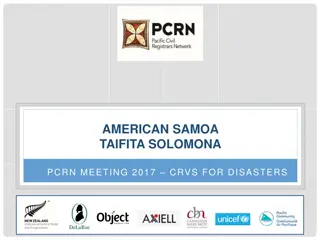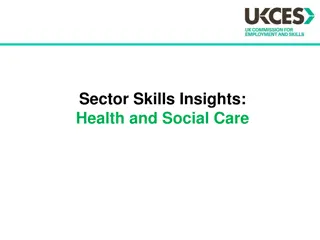The Role of Health Sector in CRVS Systems
The health sector serves as both a beneficiary and contributor to Civil Registration and Vital Statistics (CRVS) systems, playing a crucial role in informing health policies and priorities, understanding demographic trends, and monitoring health outcomes. CRVS data is vital for setting strategic agendas, formulating policies and programs, and evaluating progress towards achieving health-related Sustainable Development Goals (SDGs), with a focus on improving public health and well-being across all age groups.
Download Presentation

Please find below an Image/Link to download the presentation.
The content on the website is provided AS IS for your information and personal use only. It may not be sold, licensed, or shared on other websites without obtaining consent from the author.If you encounter any issues during the download, it is possible that the publisher has removed the file from their server.
You are allowed to download the files provided on this website for personal or commercial use, subject to the condition that they are used lawfully. All files are the property of their respective owners.
The content on the website is provided AS IS for your information and personal use only. It may not be sold, licensed, or shared on other websites without obtaining consent from the author.
E N D
Presentation Transcript
A Valuable Resource: Health Sector as a Beneficiary and Contributor to CRVS Systems
HEALTH ECONOMIC PLANNING DATA; POPULATION AND GROWTH; POPULATION STRUCTURE; HEALTH AND AGEING PROFILE . HEALTH PLANNING AND RESOURCING; FERTILITY; IMMUNIZATION; MORTALITY; LIFE EXPECTANCY; DISEASE BURDEN; POPULATION . SOCIAL SOCIAL PLANNING AND RESOURCING; EDUCATION; CHILD PROTECTION; RIGHTS; AGEING .. STATISTICS FERTILITY; MORTALITY; LIFE EXPECTANCY; INTER-CENSAL POPULATION ESTIMATES; PLANNING DATA; DENOMINATOR GOVERNANCE CONFIRMATION OF IDENTITY IN POPULATION; ACCESS TO SERVICES, ELECTION-ELIGIBILITY . LEGAL IDENTITY INDIVIDUAL IDENTITY; ACCESS TO SERVICES; CITIZENSHIP; ACCESS TO LEGAL INSTITUTIONS SUCH AS MARRIAGE CIVIL REGISTRATION AND VITAL STATISTICS SYSTEMS LEGAL IDENTITY, DATA
Importance of CRVS to Health Country policy and planning, especially mortality data, but also population data Setting health policies and priorities Establishing health implementation needs Understanding routine delivery needs and progress Monitoring and evaluation.
CRVS data is important to the whole Health Policy Cycle Population health issues: eg population growth, ageing, leading causes of death, avoidable deaths, MNCH deaths, communicable / non communicable Issue identification CRVS data supports the initiation or alteration of existing policy program eg prevention programs, new forms of service delivery. CRVS data critically underpins planning especially with population and health specific information. Set Strategic Agenda CRVS data can be used to support the identification of policy or delivery options and the most appropriate policy response Formulate Policy and Programmes Create baseline using national mortality data and measure progress. Monitor and evaluate
Africas peoples are vulnerable to non- communicable diseases
Post 2015 Health-related SDGs Overall goal :Ensure healthy lives and promote wellbeing for all at all ages 1 Reduce the global maternal mortality ratio to less than 70 per 100,000 live births 2 End preventable newborn and under-5 child deaths 3 End the epidemics of AIDS, TB, malaria and NTD 3 And Combat hepatitis, water-borne diseases and other communicable diseases 4 Reduce premature mortality from NCDs through prevention and treatment and promote mental health and wellbeing 5 Strengthen prevention and treatment of substance abuse, including narcotic drug use and harmful use of alcohol 6 Reduce deaths and injuries due to road traffic accidents 7 Ensure universal access to sexual and reproductive health-care services 8 Achieve Universal Health Coverage 7
Quality of CRVS data is an issue for countries and for global health 8
06 Social Education planning, families, ageing, vulnerable groups 02 Legal Identity and Governance Identity, rights, access 01 CRVS System All births, all deaths, all causes of death 03 Data Population, mortality, fertility, life expectancy 05 Economics Economic planning, growth, population change 04 Health Health policy, health planning, health delivery, health coverage, financial protection.
2020 2025 2030 Targets Births in given year are registered 80% 90% 100% 90% 70% 85% Children whose births are registered have been issued certificates Deaths in given year reported, registered, and certified with key characteristics Maternal and newborn deaths reported, registered, and investigated Deaths in children under 5 reported, disaggregated by age and sex Cause of deaths in hospitals reliably determined and officially certified Countries have community assessments of probable cause of death determined by verbal autopsies using international standards 60% 70% 80% 80% 90% 100% 60% 70% 80% 80% 90% 100% 50% 65% 80% 10
Opportunity: CRVS Systems and Health Innovation Better Data for Health . And many other things Civil Registration and Vital Statistics Systems (centralised or decentralised) Outreach: in hospitals At health related one stop shops immunization points Routine Linkage: Hospital Notifications Mortuary data Death records - Police Other health data Active Collection: Integrating: verbal autopsy collections MNCH tracking systems MDSR processes Survey / census collections 11
Building a National CRVS System: Civil Civil Civil Civil Civil Civil Civil Civil Registration Registration Registration Registration Registration Registration Registration Registration LINK: Health Information LINK: Health Information LINK: Health Information LINK: Health Information LINK: Health Information LINK: Health Information LINK Systematic Community Births LINK Systematic Community Births LINK Systematic Community Births LINK Systematic Community Births LINK Systematic Community Births Develop birth registration strategy ADD and LINK Systematic Community Mortality Collection ADD and LINK Systematic Community Mortality Collection ADD and LINK Systematic Community Mortality Collection ADD and LINK Systematic Community Mortality Collection ADD and LINK Systematic Community Mortality Collection Develop mortality strategy Vital Statistics Estimates Vital Statistics Estimates Vital Statistics Estimates Vital Statistics Estimates Vital Statistics Estimates Vital Statistics Estimates Using Census and / or National Surveys for national CRVS data
Mortality Systems - Why? Information on causes of death is indicative of the overall health status or quality of life of a population. Countries should have the capacity to report leading causes of death that account for large numbers of deaths within a specified population group and time period. Hospitals are important sources of mortality data because they are generally the only source of medically certified deaths. 13
Health and Vital Statistics Common statistics derived from aggregate hospital records include total institutional deaths by sex and age group and by major causes. Important facility-based indicators that can be derived from such data include: All cause hospital mortality rates by age group and sex per 1,000 admissions; Distribution of causes of death by sex and age group; Cause-specific case fatality rates per 1,000 admissions for major causes by sex and age group; Institutional maternal mortality ratio (facility maternal deaths per 100,000 facility deliveries). 14
6 Steps to Build a Health Facility Mortality Statistics System Step 2: International Medical Certificate form Step 3: Medical certification Step 1: Governance Step 4: Code to ICD Step 5: Compile and Analyse the Data Step 6: Use the Data . Health Facility Mortality Statistics System 15
Community Deaths 1. Develop a baseline report from all available information about community deaths available data from surveillance, sample surveys, administrative data sources such as community health, mortuaries, police records. NOT REPRESENTATIVE but it tells you what is there 2. Work to integrate these sources into a mortality system. INTEGRATION OF SOURCES IS THE KEY 16
Example: Main hospital mortality collection in Laos CRVS system is being established. Only main hospital codes causes of death to an ICD shortlist. Death Notification Medical Certification Medical records system We learned: Mortality is a critical source of monthly data for this health facility, in managing its core business. There is clearly value in these data for policy and planning within the hospital, and that is why it continues to be collected. IT DOES NOT YET LINK TO THE CRVS SYSTEM BUT IT CAN Coded and counted into Main Hospital Statistics reported monthly Hospital statistics and reporting Health priorities. Planning and service delivery. Financing including required hospital resources. Monitoring. 17
Example: Australian Mortality Collection Major points: Death Notification Medical Certification Police Coroner Health is a critical source of data to the national system, especially data from health facilities. Autopsy and other data eg Toxicology Registrar NCIS Funeral Director Coded and counted into National Statistics Global Data More than one health data source has to be usedand collection is drawn together to produce national statistics. Health sector extensively uses its own data, as well as national data. Health data acts also as a check for national data system. State / Local statistics. for planning and delivery: Economic planning; government financing. Arrangements; social policy and programs eg indigenous programs National statistics and reporting priorities and progress: economic planning; government financing arrangements; social policy and programs eg indigenous programs Health: statistics for planning and delivery Health priorities, inequities, regions. Health planning and service delivery. Health Financing including insurance. Health monitoring and progress. There is exponential value of these data for policy and planning 18
Example: Systemic Thinking from Mozambique / Many other countries Death Notification Medical Certification Emerging thinking: Focus on strengthening hospital data as a core of hospital information and the strengthening of the CRVS system. Accommodate Multiple Mortality Collections SISROH Fatal injuries Centralised National Health Data Base (based on SIS ROH) Surveillance Actions: Assess the quality of mortality data from different sources Create a centralized database. (Built upon the SIS- ROH database) Generate annual reports HIV / TB Annual Reporting Global Data? 19
Better mortality statistics from CRVS systems today will help improve her health tomorrow 20























